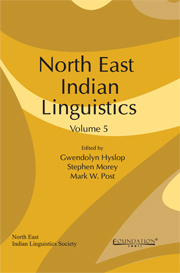13 - Wihu song of the Pangwa Tangsa: Poetry and linguistic forms, meaning and the transformation into a symbol of identity
from Poetics and text
Published online by Cambridge University Press: 05 September 2013
Summary
Introduction
The Tangsa (Tangshang) people of North East India and Myanmar comprise many sub-tribes, almost all of them having distinctive varieties of oral language and cultural features. The distinctive language varieties are in some cases mutually intelligible, but in other cases they are so divergent as to be unintelligible. The Tangsa have lived and moved about in the Patkai Hills on what is now the India-Myanmar border for a very long time, but in the last several hundred years there has been a progressive movement of Tangsa people down to the plains of Assam from the hills of Burma and Arunachal Pradesh. Since the early twentieth century, there has also been adoption of established world religions, first Buddhism and later Christianity. More recently some Tangsa groups have adopted Rang Fraa (also spelled Rangfra and Rangfrah), a kind of codification of the traditional beliefs supported by Hindu organizations like the Vivekananda Kendra. These changes in recent times have had a big impact on the continuity of their cultural traditions.
In this paper, we would like to explore in detail the social and linguistic background to the Tangsa traditional Wihu song, which exists among the Pangwa (see section 2) subtribes who are now mostly Christian. The Wihu song is sung in different cultural settings, but essentially it is a part of the ritual of praise to the spirit of mother earth (Wihu). There are several styles of Tangsa songs, of which Wihu is one. These styles can share the same content – the same set of words being used in a sacrifice song, a spirit calling song or even a love song (see Morey 2012; Morey and Schöpf in press).
- Type
- Chapter
- Information
- North East Indian Linguistics , pp. 283 - 303Publisher: Foundation BooksPrint publication year: 2013
- 1
- Cited by



